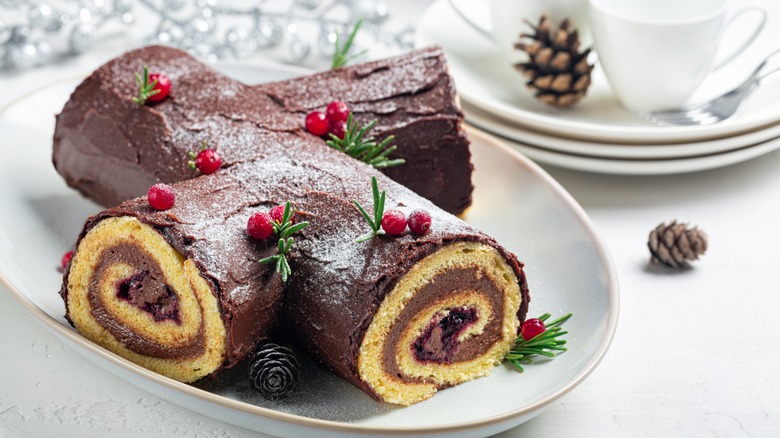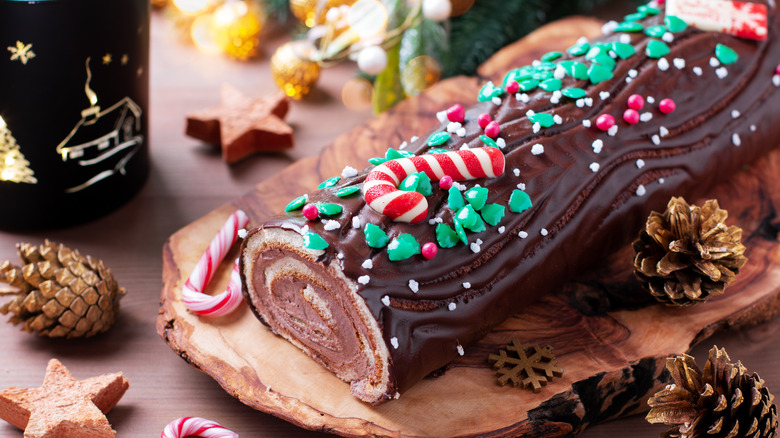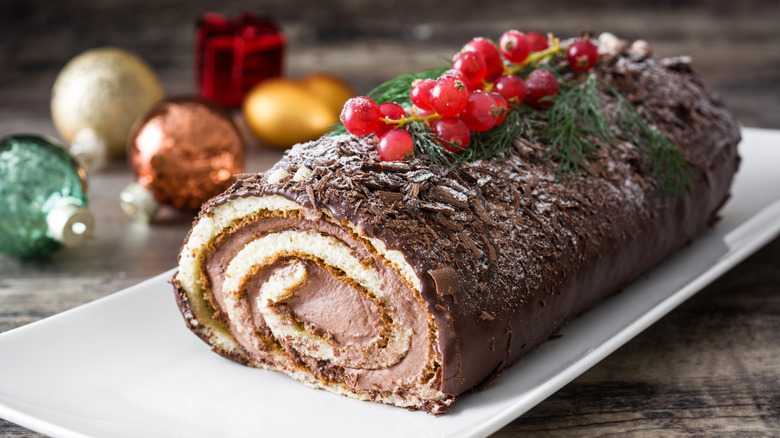How To Properly Roll A Bûche De Noël Cake And Avoid Holiday Disaster
Christmas may not have that many signature dishes, but it does have a few — and most of them are desserts. Peppermint bark, fruitcake, gingerbread houses, rum balls, pavlova — apart from ham (which you can eat at any time of year) and eggnog, there are few non-dessert foods associated with the Christmas season. And of all the Christmas desserts, the most iconic might be the Bûche de Noël cake, also known as the yule log. Yule logs originally became associated with Christmas through the Vikings, but now, they're a classically Christmas confection.
You've undoubtedly seen a Bûche de Noël before and have probably tried a slice. But have you ever made one yourself? It's not an endeavor for the faint of heart. You've got all the common aspects that can make baking difficult, of course — exact measurements and ratios, and tricky or inconsistent ovens — but with a Bûche de Noël, there's an added element of difficulty: rolling the thing. So, how do you roll a yule log without it becoming a sticky disaster in confectionary deforestation? Patience, care, and a measured hand.
Roll the cake before you fill it
Getting the cake right is the first step — and arguably the hardest one. The sort of cake we're familiar with isn't typically known for its pliability, at least not in spiral patterns, so you really have to get it right here. You want extremely whipped eggs for this because the increased aeration will result in a more yielding cake. You need to get the baking time right, too because an overcooked cake won't roll without coming apart, and an undercooked one won't set in the first place.
The rolling process, meanwhile, starts not long after you remove the cake for your Bûche de Noël from the oven. While it's still warm, roll it up unfilled until it finishes cooling. This increases pliability, ensuring it remembers the shape you want. Don't just do it on the counter, though; use parchment paper on the outside of the cake as you roll to keep it from sticking to itself. The first roll should be tight, but the rest should come naturally. If you roll the cake too tightly, it'll crack. From there, it's on to the filling.
Don't overfill the Bûche de Noël
While the filling seems like a self-explanatory part of the process, there's a key to it here, and that's not to overfill anything. It's often problematic for Americans to accept that less is more; we're taught almost from birth that, in fact, more is more, and we should want more of everything. But when it comes to baking, especially baking something like a Bûche de Noël, too much of a good thing ruins the entire endeavor. If you overfill your Bûche de Noël, you will cause it to crack as it struggles to contain its filling. Leave spaces at the end, too, so the filling doesn't come out the sides when you roll it back up. Go slowly; there's no reason to rush the process when you've already come this far. At the end of it, your yule log should be rolled up and ready for decoration and serving.
If you follow these simple steps, the result should be a Bûche de Noël cake of which you can be proud. Just make sure to take your time and don't expect it to come out perfectly on the first try.


